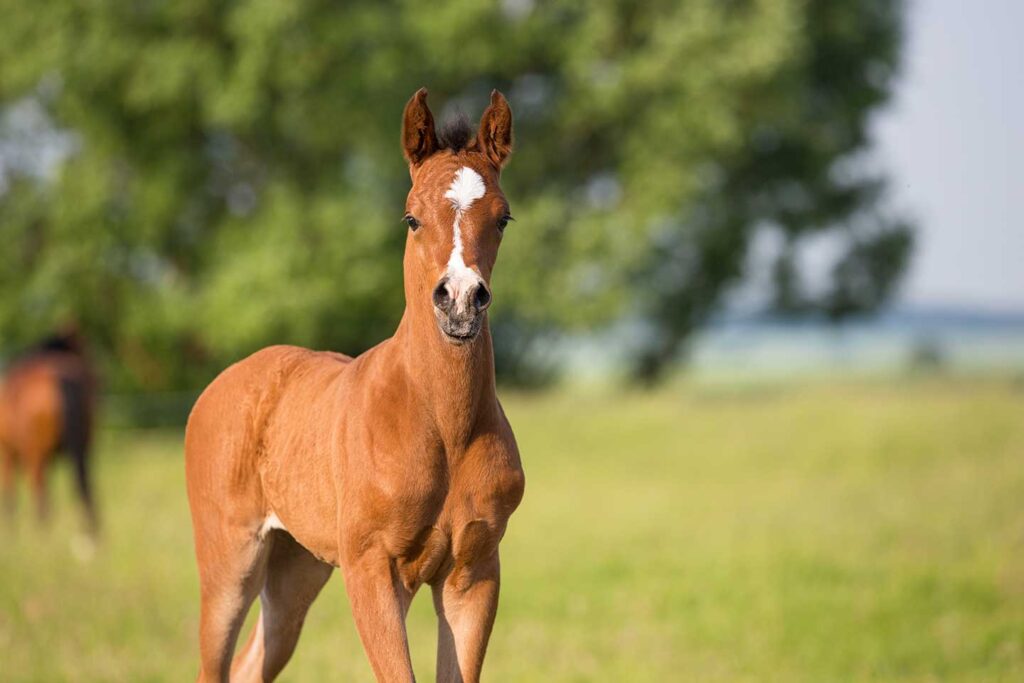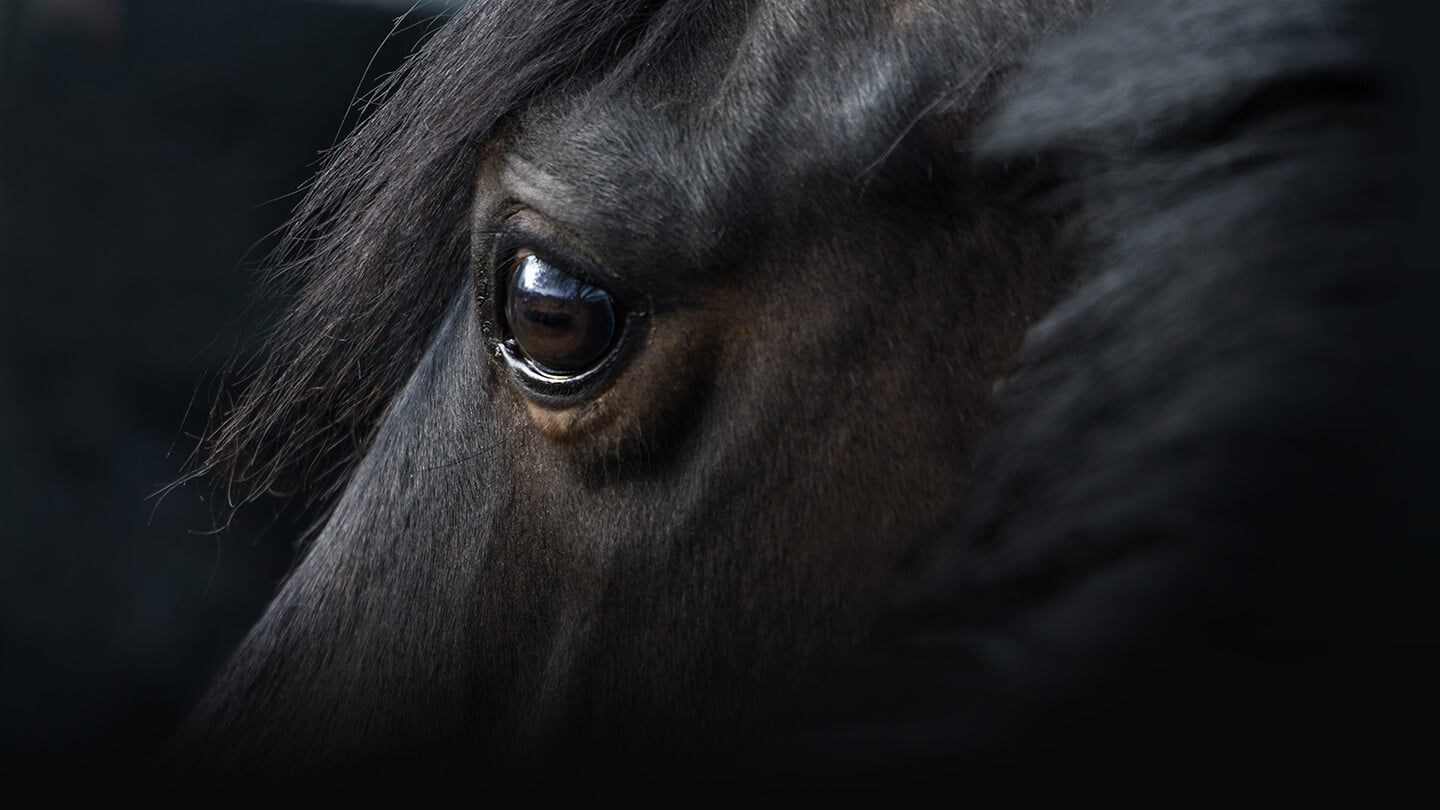Introduction
The goal of most breeding programs is to produce a sound athlete, whether for the show ring or the trail. Nutrition plays a big role in the proper development of the young horse – a process that begins with nourishment in the womb and continues until they reach mature size. This article will address feeding the mare during pregnancy and lactation, as well as feeding programs for nursing foals, weanlings and yearlings.
Feeding the Pregnant Mare
Over 60% of fetal growth occurs during the last 3 months of pregnancy. However, the mare’s requirements for protein, energy (calories) and minerals begin to increase in the 5th month of gestation and remain elevated until she foals. Therefore, the diets of pregnant mares need to be adjusted, particularly for the last half of pregnancy, to account for the increased nutrient demand by the growing fetus.
To enable proper bone and cartilage development in the fetal foal, minerals are perhaps the most critical of nutrients to ensure are provided in sufficient quantities to pregnant mares. Whereas protein and energy requirements increase 30% during mid- to late gestation, calcium and phosphorus requirements of the pregnant mare almost double by the last trimester.
Example diets for pregnant mares are provided in Table 1. Total dietary intake usually ranges from 2.0 – 2.25% of body weight. Mares in healthy body condition (score of 5-7 out of 9) who are also not simultaneously lactating (due to overlapping gestation/lactation cycles) often do not need concentrate until the middle of gestation. Instead, good quality forage can often meet their protein and energy requirements. However, forage alone usually cannot meet the higher mineral and vitamin needs of pregnant mares. In such cases, a concentrated mineral-vitamin supplement could be used to complement the forage. Because intake from a mineral block or free-choice mineral feeder can be erratic, a better option is to feed a fortified “ration balancer” pellet each day. Ration balancers typically contain a higher concentration of protein (24-32%), calcium (2-4%), phosphorus (1-2%), trace minerals, and vitamins than a traditional feed, and thus can be fed in smaller quantities (1-3 pounds per day). When good quality forage is not available, then a traditional fortified concentrate may be necessary to meet the requirements of mares in early to mid gestation. In late gestation, a fortified concentrate is often necessary to meet the mare’s elevated requirements. A concentrate formulated for broodmares should be selected, as they usually contain higher levels of protein, energy and minerals compared to feeds formulated for other types of horses. The same concentrate can also be used to feed the mare during lactation, so beginning its use during gestation will help make the transition to lactation easier. If the mare is fed at least 0.5% of body weight as concentrate (~5 Lbs for most light breed mares) in late gestation, then the ration balancer supplement can be discontinued.
Many mares are rebred within 30-60 days after foaling. As a result, the early gestation period can overlap with lactation. In such cases, the mare should be fed as a lactating mare (Table 2)
Feeding the Lactating Mare
Once the foal is born, he is reliant on the nutrients in milk produced by the mare. The foal also begins to eat solid foods at a relatively young age, including sampling the mare’s feed. Therefore, it is important to understand how to best feed a lactating mare in order to support continued growth and development of the foal.
Development of the udder along with production of an average of 4 to 5 gallons of milk per day presents a large drain on the reserves of the mare, and dictates the need for daily replenishment of nutrients from the diet. With the onset of lactation, the mare’s protein requirement increases an additional 75% and energy requirement increases an additional 50% over what she needed in late pregnancy. Lactation also results in the need for additional vitamin and mineral intake, including a 64% increase in calcium and 46% increase in phosphorus compared to late gestation
 Example diets for lactating mares are provided in Table 2. Total dietary intake for most lactating mares will exceed 2% of body weight and some will consume more than 3% of body weight. The feeding of a fortified concentrate is generally necessary to meet the very high nutrient requirements of a lactating mare. Again, a commercial feed formulated for broodmares should be used, because of the higher protein, mineral and vitamin concentrations associated with these products. Even better, a concentrate suitable for growing horses should be fed to lactating mares, since the foal will begin sharing the mare’s concentrate as early as a few weeks of age. Most feed companies offer a single formula suitable for feeding broodmares and foals (ie, “mare and foal” formula). It is also helpful if this product was the same one used during late gestation, so the mare is already adapted to it after foaling.
Example diets for lactating mares are provided in Table 2. Total dietary intake for most lactating mares will exceed 2% of body weight and some will consume more than 3% of body weight. The feeding of a fortified concentrate is generally necessary to meet the very high nutrient requirements of a lactating mare. Again, a commercial feed formulated for broodmares should be used, because of the higher protein, mineral and vitamin concentrations associated with these products. Even better, a concentrate suitable for growing horses should be fed to lactating mares, since the foal will begin sharing the mare’s concentrate as early as a few weeks of age. Most feed companies offer a single formula suitable for feeding broodmares and foals (ie, “mare and foal” formula). It is also helpful if this product was the same one used during late gestation, so the mare is already adapted to it after foaling.
The feeding of high quality forages to mares will help lessen the need for large quantities of concentrate. Depending on the time of year, the first few months of lactation (when milk production is highest) may or may not coincide with high quality pasture availability. When possible, early to mid-maturity grass/legume mix hays or mid-maturity legume hays should be utilized for lactating mares and their foals. Greater amounts of concentrate (> 1% of body weight) will likely be needed when grass hays or lower quality, late-maturity hays are provided as the forage source. Such high intakes of grain-based concentrates are associated with an increased risk of digestive disturbances. When high concentrate intakes are necessary, the concentrate should be divided into two or three meals per day. In addition, all increases in concentrate to accommodate lactation should be made gradually to reduce the risk of colic and other digestive problems.
The body condition of the mare has been shown to impact fertility and reproductive performance. Non-pregnant mares in good body condition (score at or above 5) at the onset of the breeding season will generally have higher conception rates and will require fewer cycles to conceive. Mares in thin body condition have a longer anovulatory or transitional period, resulting in delayed or unsuccessful breeding in the spring. Pregnant mares that foal in a thin body condition at the onset of lactation may also have reduced reproductive efficiency. Therefore, feeding programs for lactating mares may have to be adjusted beyond that listed in Table 2 to minimize weight loss and/or encourage weight gain if the mare is to be rebred. Ideally mares (pregnant or lactating) should be fed to maintain a body condition score of 5 to 7.
Bridging the Nutrition Gap in Nursing Foals
Milk makes up the majority of the foal’s diet for the first few months of life. However, at about 2 months of age, a discrepancy starts to develop between the amount of nutrients provided in milk and the steadily increasing requirements of the rapidly growing foal. This phenomenon may be nature’s way of prodding the foal to seek out and consume solid foods to make up the difference for what’s lacking in milk. Ultimately, it is important for nursing foals to have access to high quality forages and concentrates that are compatible with its requirements.
Many foals will share their dam’s concentrate and forage – this is why it is a sound practice to feed the lactating mare a commercial fortified concentrate that is suitable for foals. However, the foal may not be able to compete with the mare (or the herd) for an adequate amount of feed. In addition, given their smaller body size, yet higher nutrient requirements, foals require a more nutrient-dense ration than adult horses. So many feeds that can meet the needs of mares and other horses the foals might be housed with are not suitable choices for foals.
 Creep feeding is a management practice whereby the foal is given exclusive access to a nutrient-dense concentrate. It can be accomplished with a special foal feeder (with adjustable bars big enough to admit the foal’s nose, but not the mare’s) placed in the stall where the mare and foal are fed. Alternatively, a creep feeding station can be constructed in the pasture with simple materials (eg, setting a board rail at a height to admit foals but not mares in one corner of the pasture). Ideally, the creep feeder would be placed in a location where mares and foals spend the majority of their time. This allows foals to “creep” in and nibble on feed whenever they want, essentially mimicking a pattern of frequent nursing with small meals of concentrate. By comparison, use of a creep feeder in a stall where mares and foals are brought in twice daily for feeding forces the foal to eat larger, more distinct meals, which may have undesirable metabolic side effects.
Creep feeding is a management practice whereby the foal is given exclusive access to a nutrient-dense concentrate. It can be accomplished with a special foal feeder (with adjustable bars big enough to admit the foal’s nose, but not the mare’s) placed in the stall where the mare and foal are fed. Alternatively, a creep feeding station can be constructed in the pasture with simple materials (eg, setting a board rail at a height to admit foals but not mares in one corner of the pasture). Ideally, the creep feeder would be placed in a location where mares and foals spend the majority of their time. This allows foals to “creep” in and nibble on feed whenever they want, essentially mimicking a pattern of frequent nursing with small meals of concentrate. By comparison, use of a creep feeder in a stall where mares and foals are brought in twice daily for feeding forces the foal to eat larger, more distinct meals, which may have undesirable metabolic side effects.
To counterbalance the nutrient deficit in milk, creep feeding should begin when foals reach 2 months of age. As a rule of thumb, a foal should be offered 1 pound of creep feed per month of age. Fresh creep feed should be put in the feeder daily and older, uneaten feed removed regularly to encourage intake. Frequent monitoring of creep feed consumption can permit timely intervention when a foal is consuming more than desired, particularly when groups of foals have access to the same creep feeder.
Ideally, the feed used in the creep feeder should be a product designed for this purpose. In most cases, a commercial fortified feed formulated for broodmares and growing horses will work well (“growth” or “mare and foal” formula). If this is the same feed the lactating mare receives, it has the added benefit of being familiar to the foal, which encourages intake. Many of the larger feed companies also offer “transition” feeds that are used to transition orphan foals from milk replacers to more traditional concentrates. These transition feeds also work well as creep feed, particularly for very young foals.
Some horsemen have concerns that creep feeding promotes a more rapid rate of growth and may predispose foals to developmental orthopedic disease. Properly done, creep feeding can actually reduce the risk of problems with skeletal development. Creep feeding offers several benefits, the most important of which is to bridge the nutrient gap created by declining milk quality, as well as seasonal fluctuations in pasture nutrient content. Keeping foals on a consistent plane of nutrition helps to promote a steady rate of growth, thus avoiding growth slumps, which are often followed by growth spurts. Uneven or disturbed rates of growth are thought to increase risk of developmental orthopedic disease. For mares that are poor milk producers, creep feeding is even more important, giving foals an outlet to obtain the necessary nutrients for proper growth. Creep feeding can also make weaning less stressful by encouraging significant consumption of solid feed before weaning. And if the same feed used for creep feeding is fed to foals after weaning, the foal will be more familiar with its new diet.
Feeding Weanlings and Yearlings
 Young growing horses are the most sensitive to dietary nutrient supply, making it essential to pay close attention to their feeding programs. The high nutrient requirements, yet smaller digestive capacity in young horses necessitate the feeding of a very nutrient-dense diet compared to the average adult horse. Every effort should be made to provide weanlings and yearlings with a high quality source of forage. When hay is offered, use of early- to mid-maturity grass/legume mix hays or early-maturity grass hays will go a long way in helping to meet the nutrient demands of the young horse. Ideally, the young horse should be offered all the forage they want to eat, with an expected range of intake between 1-2% of body weight (on the lower end for weanlings, the upper end for long yearlings (Table 3).
Young growing horses are the most sensitive to dietary nutrient supply, making it essential to pay close attention to their feeding programs. The high nutrient requirements, yet smaller digestive capacity in young horses necessitate the feeding of a very nutrient-dense diet compared to the average adult horse. Every effort should be made to provide weanlings and yearlings with a high quality source of forage. When hay is offered, use of early- to mid-maturity grass/legume mix hays or early-maturity grass hays will go a long way in helping to meet the nutrient demands of the young horse. Ideally, the young horse should be offered all the forage they want to eat, with an expected range of intake between 1-2% of body weight (on the lower end for weanlings, the upper end for long yearlings (Table 3).
Offering a suitable concentrate will also be necessary to support growth. Commercially available fortified feeds that have been formulated for growing horses (“growth” formula) generally contain higher levels of protein (14-16%), lysine (0.8%), minerals (0.9% Ca, 0.6% P) and vitamins than feeds formulated for mature horses or performance horses. In many cases, the product may be marketed as a “mare and foal feed” where it can be fed to the lactating mare, used as creep feed for the nursing foal, and later used to feed the foal once weaned. The amount offered will vary based on age, forage quality and desired growth rate (Table 3).
Lori K. Warren, Ph.D., PAS
Associate Professor, Equine Nutrition
Department of Animal Sciences
University of Florida, Gainesville





